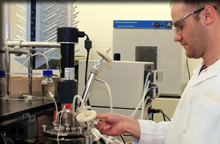Researchers working at the Department of Paper and Bioprocess Engineering in SUNY College of Environmental Science and Forestry (ESF) are studying methods to convert wood into green biobutanol.
 ESF researchers are working with bacteria
ESF researchers are working with bacteria
The researchers are currently concentrating in the development of biobutanol with the belief that it will become the biofuel of the future.
Biobutanol is one among the few fuels that can be manufactured using wood sugars. The type of fuel varies with the kind of organism deployed to ferment the derived sugar. The biobutanol fuel, which is more efficient than the currently utilized ethanol also can be used as a platform chemical for other functions including its use as jet fuel.
According to Dr. Timothy Volk, from the Department of Forest and Natural Resources Management in ESF, who also leads the college’s Willow Biomass Project that utilizes the shrub willow as a clean energy source, the use of biobutanol in place of ethanol in the commonly known gasoline mix E10 (10% ethanol 90% gasoline) has a number of advantages. He said that biobutanol has increased energy efficiency than ethanol and can be used in the present gasoline distribution set up without making any infrastructure changes.
The study that is undertaken in a laboratory at the ESF campus located Walters Hall by the team of researchers led by Dr. Shijie Liu, currently researches the effectiveness of deploying various bacteria strains to ferment the mixed sugars such as xylose and glucose derived from wood into biobutanol. The lab utilized wood biomass materials such as wood chips and willow cuttings to process them along with water to derive xylose and glucose.
The researchers used Clostridium acetobutylicum, a bacterium strain often utilized in the fermentation procedures by the industry to ferment the derived mixed sugars into butanol. Liu and his students used the laboratory equipped with an anaerobic chamber to tweak the choice of microorganisms for use in the fermentation procedures and a bioreactor to complete the fermentation process.
The research of Liu received a grant of $400,000 through the U.S. Department of Energy and the New York State Energy Research and Development Authority provided a funding of $75,000.